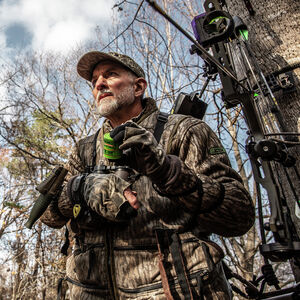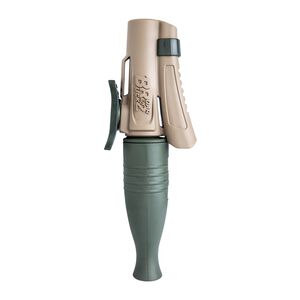Calling deer can be fun and effective, but there are a few things that you can do before you ever climb into the stand to make your deer calling lead to a successful hunt.
1. BLOCK THE WIND!
Deer’s number one defense mechanism is its nose! If he hears a deer call and wants to investigate the source, he’s going to circle downwind and smell what’s actually going on before he shows himself. If that buck is able to get downwind, the gig is up because instead of smelling a doe, Mr. November just picked up on your lack of hygiene! This is where you can position certain stands to optimize your chance of getting him within range. Using a body of water is our number one way of rendering a deer’s sense of smell useless. We’ll put a tree stand or a ground blind 30-100 yards upwind of a body of water, depending on the thickness of woods. If the timber is open, then you can get off the edge of the water further, because if he circles downwind, you’ll be able to see him and get a shot before he winds you. Conversely, if the woods are thick, you’re going to want to get closer, because he might be only 50 yards away and you’ll never see him slip behind you.
If you are hunting in an area with a lot of terrain, you can position yourself up against it, so the deer are going to have to put too much effort to get behind you. Open farm fields or pastures can also work, especially when hunting old bucks. They aren’t necessarily going to want to expose themselves in the wide open to get downwind of you, and you can use this to your advantage. Set up facing the woods with the field at your back, and even if the deer get into the field to the side of you, you’ll be able to get a shot before he gets directly downwind.
2. LEAVE A LITTLE TO THE IMAGINATION!
Like I said before, a deer’s main sense is its nose, but old bucks didn’t get old because they only used their nose! You also have to get into a situation where you can trick his eyes too. Imagine this scenario. You are bowhunting a beautiful open mature oak flat, and you see a big old 150” bruiser 200-yards away. The Original Can Doe Bleat comes out of your bow vest, and you peak his attention. Ears perk up, and big boy is looking. Then you hit him with the buck roar and he just stands there looking. Finally, after a few minutes he just continues on his way. Why didn’t he come? A deer’s eyesight and his ability to hear is incredible, to the point where they’ll often pinpoint exactly what tree you were calling from, hundreds of yards away. This is exactly what happened to Will Walker in the video above! Keep this in mind as we return to our scenario. That deer could pinpoint exactly where that sound was coming from when you were calling. He sat and watched, but never saw the deer making the noise, so he went on his way. This is where your set up comes into play! We like calling with a thick area either right behind you, or in front of you. This makes the deer get closer to your location to investigate where he heard the sound. He can’t see very far when it gets thick so he has to use his legs, bringing him right into your wheelhouse!
3. BE WHERE THE DEER WANT TO BE!
The pre-rut and rut time periods are the best times to call deer. Bucks are on their feet and cruising around scent checking bedding areas for does. Painting a realistic picture for a buck is the best way to put your tag on him. If you have a known bedding area, hang your stand on the downwind side, with the distance depending on the thickness, and whether you are bow hunting or rifle hunting. If there is a buck in that bedding area searching for does, it’s not going to take much convincing for him to come to the edge of that bedding area to investigate where the commotion is coming from.
The same goes for pinch points connecting two tracts of land. Big deer aren’t going to want to expose themselves in the open like we talked about, so they’ll use even the thinnest strips of cover to crossover from one chunk of habitat to the other. It’s especially true during the rut, as they are on their feet cruising more than any other time of the year. This is a great ambush point, and it’s an even better place to call. If you set up with the wind blowing over the open area, you can easily paint a picture for the deer. After a bleat and grunt combo, he’s thinking another buck is chasing a doe through that pinch point and it will drive him up the wall! That big buck you’ve been chasing all year will have no choice but to come down that funnel right under your feet!
VIDEO TRANSCRIPTION:
Stream the language. You know folks ask us all the time what hunting calls should I have when I go into deer woods to call up a whitetail a grunt call a set of rattling horns should I have a bleat can what’s the best? Honestly, before we talk about deer calls the one thing I want you to pay attention to and the thing you need to do that is the most important before you even start calling is your setup, that is the key to calling up any mature bucks. Sure you could set up in places and start calling with a doe can or rattling bag and calling some young bucks or some satellite bucks as we call them sometimes, but the true mature bucks you've got to put a barrier between you and them where they can't Circle down wind. Here at cottonmouth we're fortunate to have a lot of places that have a ton of water, we also have the mississippi river that runs right by the property and we use that river a lot on west winds. West winds allows us to get right on the river bank and call. And when we call, the deer have to come to us, they can't circle around downwind. Most whitetail bucks will always try to circle downwind because they want to smell what's there first before they see it they've already heard it but they want to smell it and they want to know if they can go in there and handle the situation. So if I were you before you pay attention to everything you got going with calls look for those prime calling spots where deer can't circle downwind a bluff, some water, even a thicket we've called some here at cottonmouth in the past where we've had thickets behind us huge thickets and call a deer away from a doe one time. Will Walker was hunting with us and called this buck away from the doe and we watch the footage and the deer goes like this and he goes like this and he pinpoints where we're at and he can't see because of the thicket behind us so he thinks there's a buck in that thicket with the doe so he comes investigating when Will Walker shoots him, he shoots him right at the bottom of the tree, so your setup is key you stop those bucks from circling down.






